The NVIDIA SHIELD Android TV Review: A Premium 4K Set Top Box
by Ganesh T S on May 28, 2015 3:00 PM EST- Posted in
- Media Streamer
- Home Theater
- TV
- 4K
- Shield
- NVIDIA
Graphics Performance
While the SHIELD Android TV and the underlying Tegra X1 SoC are by no means slouches on the CPU side of matters, ultimately NVIDIA is still just another ARM Cortex implementer. On the other hand when it comes to GPUs, this is where NVIDIA truly shines. As NVIDIA is first and foremost a GPU company, and as a design philosophy always invests more time and die space into GPUs than any other SoC builder (save perhaps Apple X-class SoCs), they have always led the pack on GPU performance. And with the Tegra X1 packing a 256 CUDA core implementation of the very potent Maxwell GPU architecture, an estimated 1GHz clockspeed, and all the power and cooling it needs to keep from throttling, all of the ingredients are in place for a very strong showing from NVIDIA for GPU performance.
If there’s any real downside for NVIDIA and the SHIELD Android TV here, it’s that the Android GPU benchmarking situation hasn’t really caught up with what their GPUs are capable of. The standard benchmarks work, but game benchmarks are virtually non-existent, even in the AA and AAA games NVIDIA has helped bring over to the Android/SHIELD ecosystem. So we can’t for example look at the performance of The Talos Principle in the same way as we can the PC today.
Anyhow, we’ll start off with 3DMark’s Ice Storm Unlimited benchmark.
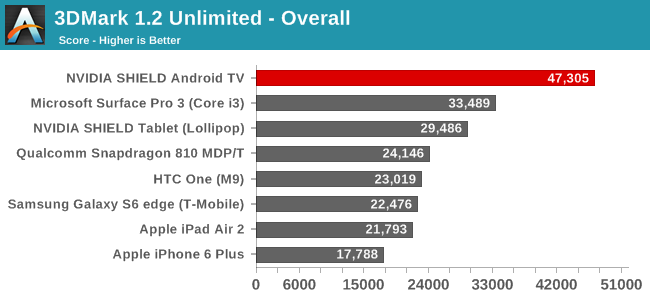
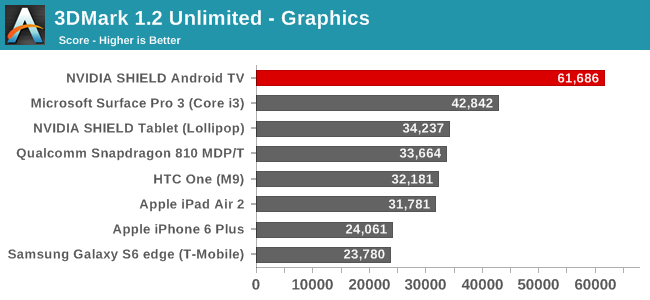
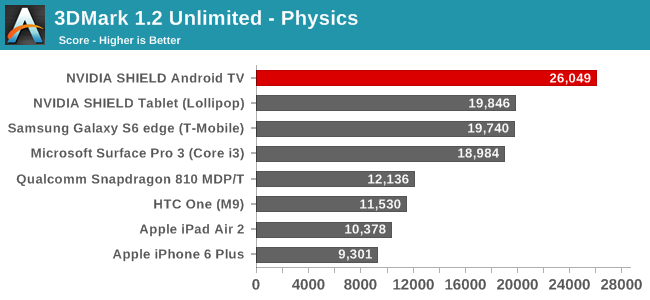
The results here pretty much speak for themselves, especially in the all-GPU graphics sub-score. SHIELD Android TV is 50% faster than the Surface Pro 3 and almost twice as fast as other devices like the iPad Air 2 and the last-generation SHIELD Tablet. Graphics workloads tend to be the most punishing from a heat and power standpoint, and hence are the most likely to get throttled. This really lets the SHIELD and its SoC open up here. At the same time, even in the physics score and the composite overall score, the SHIELD is well in the lead thanks to this combination of factors.
Up next we have BaseMark X 1.1.
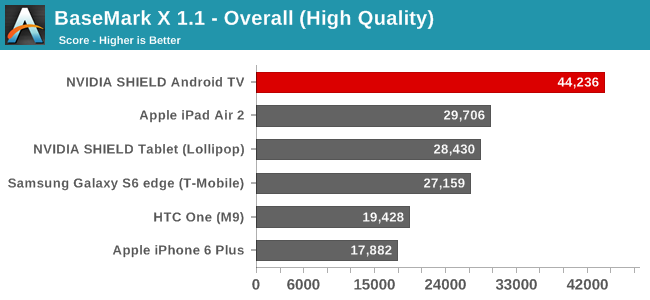
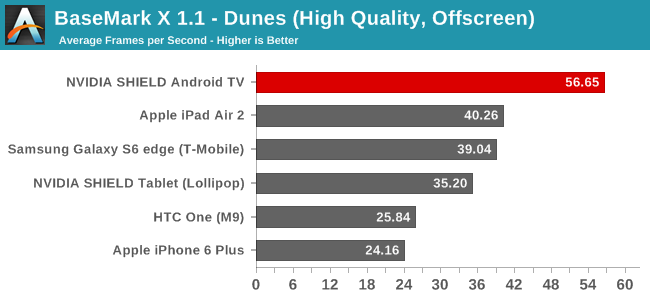

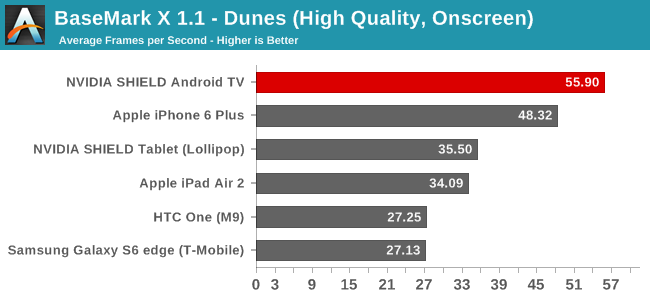
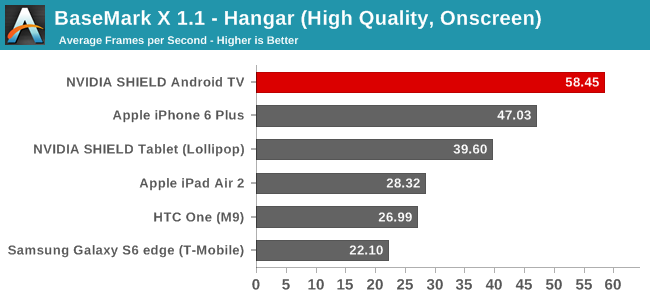
Once more it’s a clean sweep for the SHIELD. Apple’s iPad Air 2 tends to be the second-place finisher, thanks to Apple’s own significant investment in GPU resources, the SHIELD gets yet more resources and the power to fully exploit them. With all of that said, the one thing that does surprise me a bit here is that even the SHIELD can’t crack 60fps on Dunes and Hangar; BaseMark X will likely take one more generation before its tests can be completely beaten.
Our final GPU benchmark is GFXBench.

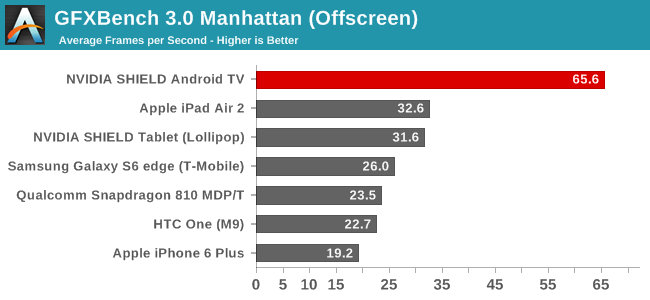
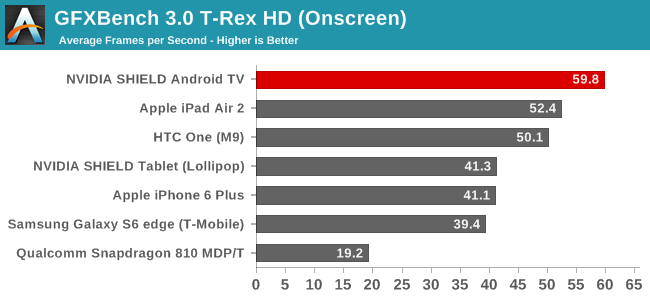
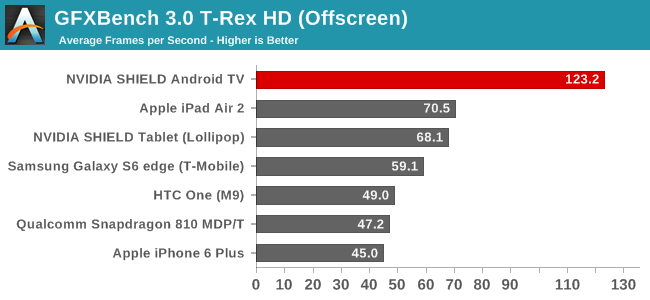
Starting first with the benchmark’s high-level tests, we once again find the SHIELD well in the lead. Of particular note here, the SHIELD Android TV becomes the first Android device to break 60fps on Manhattan, something that as recently as a generation ago seemed impossibly far away.
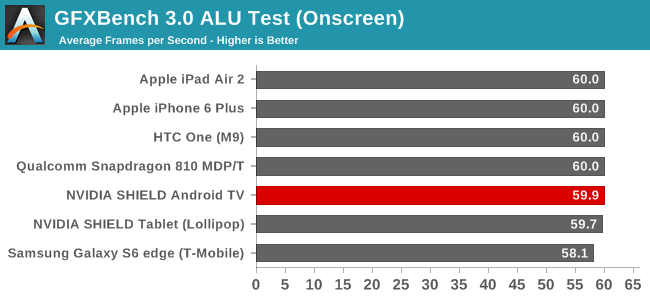
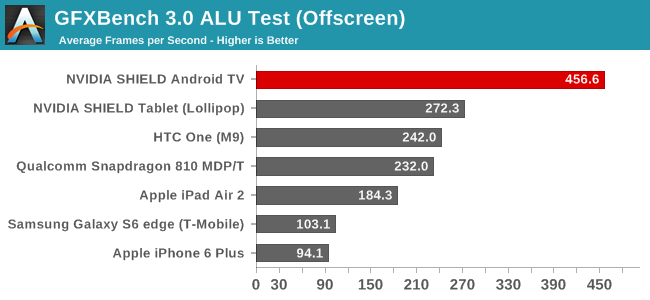

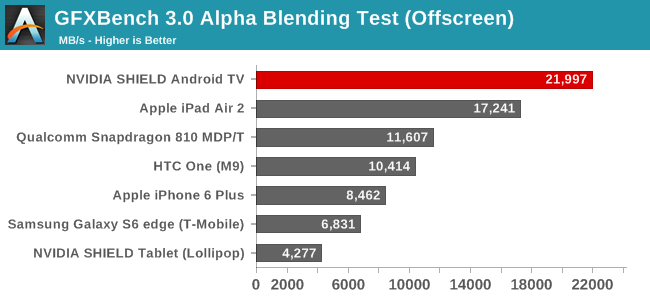
The low-level tests meanwhile offer us an interesting look at SHIELD and Tegra X1 that the high-level tests don’t provide. The ALU test for example drives home the point of just how much in the way of shading resources Tegra X1 has at its disposal (at least when unrestricted), and is a big reason why the SHIELD is doing so well here. On the other hand while NVIDIA still takes the top spot in alpha blending, the lead over the iPad Air 2 isn’t nearly as great, thanks in large part to the iPad’s relatively large 128-bit memory bus. Ultimately SHIELD doesn’t struggle here, but it’s an interesting point of comparison since it shows one of the only cases where SHIELD isn’t a run-away winner, and what kind of graphics workload may eat into its otherwise ridiculous advantage.
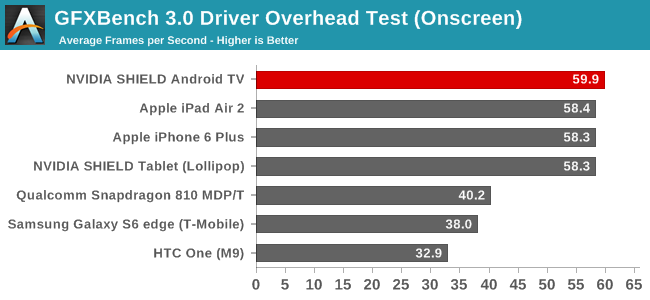
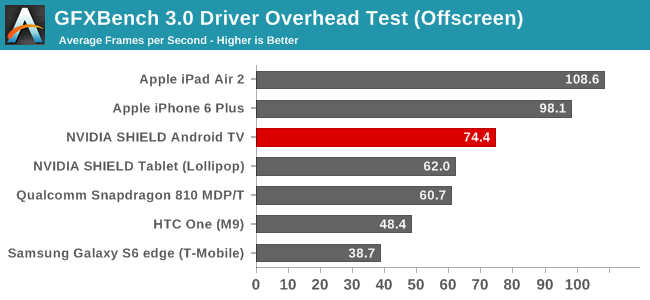
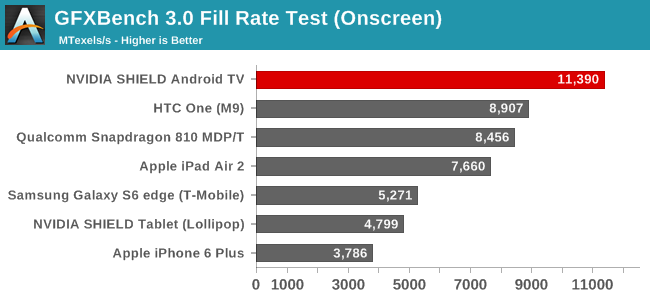
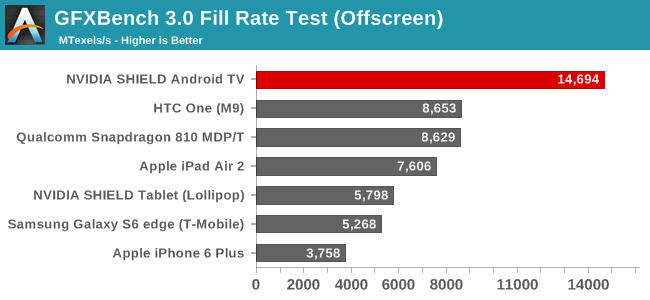
On the last batch of subtests, I’m going to stop again with the fill rate test just to point out another interesting design decision for Tegra X1 and the SHIELD. With NVIDIA banking so much on the set top box’s ability to drive 4Kp60 TVs, NVIDIA needs to push a lot of pixels to get there, as 4K is four-times as many pixels as 1080p. For this reason Tegra X1 is paired with 16 ROPs, giving it low-end PC desktop-like pixel throughput, and of course a huge advantage in the GFXBench fill rate test. And though this fill rate will help with games as well, it’s keeping up with the Android UI at 4Kp60 that is the most important reason for all of this fill rate performance.
Wrapping things up, what else is there to say about the SHIELD Android TV’s GPU performance? What we’re looking at here is twice as fast (or more) than the best phones and tablets today, a combination of the Tegra X1’s very strong GPU design and the set top’s practically unlimited energy and cooling capabilities. Overall NVIDIA is following the path they started long ago on Tegra, always favoring strong GPU performance, leading to the incredible performance we’re seeing here.
With that said, given NVIDIA’s decision to focus on the Android TV aspects of the SHIELD Android TV first and foremost – and not gaming – it’s also fair to say that the SHIELD is overpowered for Android TV work. Other than keeping up with the basic pixel fill needs of 4K, the real power of the box’s GPU is going to be left untapped by Android TV (especially on the ALU side). Which makes all of this humorously absurd in a way, but it’s also why SHIELD Android TV isn’t just an Android TV box. The device’s GPU performance will be put to good use with gaming, though stepping outside the world of benchmarks for a second, the bigger challenge NVIDIA faces is not delivering high performance, it’s delivering games that make full use of that performance.










167 Comments
View All Comments
Morawka - Thursday, May 28, 2015 - link
the chip and the wires (hdmi) have the necessary bandwidth, so shouldn't be a issue.Haydon987 - Thursday, May 28, 2015 - link
Shouldn't be in the case of dozens of currently existing devices, but in every case so far of any publicly available hardware I've seen, all encrypted content comes out 4:2:0 at 4k, so it would be nice for a vendor to acknowledge if it plays 4k hdcp 2.2 at 4:4:4 or just plays unencrypted stuff (like games, menus, ads, etc.) at 4:4:4 at 4k. Until a vendor specifically states it, I have my doubts. Sure all the features are listed to make it sound good to people who don't look too deeply into it, but they don't state when the features are interoperable.It's like a person listing for a spec sheet about themselves:
1. I can run 17 miles per hour
2. I can run 25 miles
This does not mean that this person can run 25 miles at 17 miles per hour. They are just 2 separately listed specs. Chances are they only maintain that speed for a few seconds.
In this case what is most likely:
1. I can play without color compression (4:4:4)
2. I can play protected content at 4k (hdcp 2.2), but I won't tell you if that is compressed or not.
ganeshts - Friday, May 29, 2015 - link
That is definitely an interesting question, but it is somewhat moot.. let me explain:Getting specs out of the way, the SHIELD does support RGB 4:4:4 at 4Kp60 on the HDMI port.
Now, all video content that consumers play back - Netflix or Blu-rays and the like - they are all encoded in 4:2:0 - In this case, the consumer has nothing to gain or lose whether the conversion to 4:4:4 is done on the source side or the sink side. So, HDCP 2.2 with just 4:2:0 support is fine.
On the other hand, for professional applications, where content is processed in 4:2:2 or even 4:4:4 format, it will be a problem - but, it is likely that the workflow process in that case doesn't involve protected content - the protection is applied / needed only on the consumer delivery side.
Again, this is an interesting aspect, and one that I will definitely be questioning HDMI source / sink vendors on. It is just that it doesn't matter for consumer applications.
457R4LDR34DKN07 - Thursday, May 28, 2015 - link
I'm interested in trying this with a hdhomerun prime with the live tv app. Does this android tv device support mpeg 2 decoding?457R4LDR34DKN07 - Thursday, May 28, 2015 - link
"The typical media library also includes TV programs that are interlaced MPEG-2 (for example). The SHIELD is currently not a good solution for such a case."Thanks, not for me then
Ryan Smith - Thursday, May 28, 2015 - link
The Live Channels app supports hardware MPEG-2 decoding, including deinterlacing. That functionality just isn't available to other media playback applications, since it was licensed for just the Live Channels app.DanCar - Thursday, May 28, 2015 - link
The recommendation row can be turned off partially or fully in settings -> System Preferences (3rd row) -> home screenYou can select which sources to enable and disable.
ganeshts - Saturday, May 30, 2015 - link
Somehow, I am not able to follow the path you are referring to..Under settings, I have Device > System, and under that nothing about Home Screen.. Do you have a video or set of screenshots showing the path?
I know that it is possible to go into the settings of a particular app and turn off the Notifications for that app - on Android TV, that turns off the 'Recommendations' - this is what I had done for the YouTube video showing the Android TV UI. The Recommendations row doesn't seem to have an option to turn it off completely..
BuddyRich - Thursday, May 28, 2015 - link
I was hoping they spent the money and licensed the codecs but no HD Audio or DTS (or MPEG2 or VC1) is a bummer. At least in the case of the video codecs the CPU is fast enough to decode in software. Will not replace my HTPC. Its funny they license them for their videocards, including their cheapest passive ones but not their premium set-top box. And the box doesn't even have to decode it, just pass it through to a receive, that shouldn't require a license at all.One thing that was unclear in your review though, if I use HDHomerun/Live TV app will it decode and deinterlace MPEG2 via hardware since the app is licensed? If so is this supported on Shield like it is on Nexus Player?
At least they shipped with working Netflix, unlike Razor.
webdoctors - Friday, May 29, 2015 - link
Why is a license needed if its just bit-streaming? If i connect it to my amp and my amp separates the hdmi video from the audio signals, why would the licensing matter on this box?